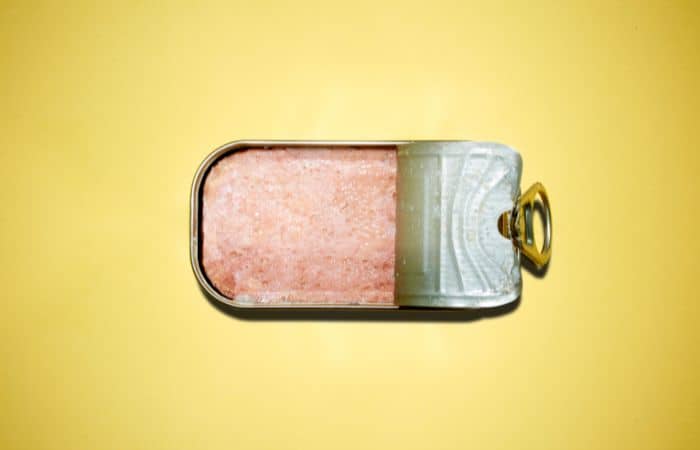Spam is a canned meat product that has been a staple in pantries around the world since its creation in the 1930s. This processed meat product, which is made from a mixture of pork, ham, and other ingredients, has been used in a variety of dishes, from breakfast to dinner, and even as a snack. However, one question that often comes up is whether or not it’s safe to eat Spam raw. In this blog post, we’ll explore the safety concerns of consuming raw Spam and provide some alternative ways to prepare and enjoy this canned meat product.

Is It Safe to Eat Spam Raw?
It is not recommended to consume Spam raw due to the risk of foodborne illness. Like any meat product, raw Spam can contain harmful bacteria such as Salmonella, Listeria, and E. coli. These bacteria can cause a range of symptoms, from mild discomfort to serious illness, and can even be life-threatening in some cases.
To reduce the risk of illness, it’s important to follow proper food safety guidelines when handling and preparing Spam. The United States Food and Drug Administration (FDA) recommends that all canned meat products, including Spam, be cooked thoroughly before consumption to kill any bacteria that may be present.
In addition to the risk of foodborne illness, raw Spam is also not very appetizing in taste or texture. The product is designed to be cooked, and its flavor and texture are greatly enhanced by heating it. While some people may enjoy the taste of raw Spam, it’s not worth the risk of illness.
In short, it is not safe to eat Spam raw. Always cook it thoroughly before consumption to reduce the risk of foodborne illness.
What Happens if You Eat Raw Spam?
Symptoms of foodborne illness from consuming raw spam may include stomach cramps, diarrhea, vomiting, fever, and dehydration. These symptoms can be mild or severe, depending on the person’s overall health and the amount of contaminated food consumed.
In some cases, the long-term effects of consuming raw meat can also be severe. For example, some people may develop a chronic infection or inflammatory bowel disease (IBD) as a result of eating raw meat. Additionally, consuming raw meat can increase the risk of certain types of cancer, such as colon cancer.

Therefore, it is essential to avoid eating raw spam and always cook it thoroughly before consuming it. Proper cooking methods can reduce the risk of foodborne illness and ensure that you can enjoy the taste of spam safely.
How to Safely Prepare and Cook Spam
To reduce the risk of foodborne illness from consuming spam, it is essential to prepare and cook it properly. Here are some tips to help you prepare and cook spam safely:
- Always wash your hands and cooking surfaces before handling spam.
- Use a clean knife and cutting board to slice the spam into the desired thickness.
- If you’re using canned spam, drain the liquid from the can before removing the spam.
- You can cook spam in a variety of ways, including pan-frying, baking, grilling, or broiling. Make sure to cook the spam until it’s browned and crispy on both sides.
- The internal temperature of the spam should reach 165°F (74°C) to ensure that all harmful bacteria have been destroyed.
- Avoid eating spam that has an unusual color, texture, or odor, as these may be signs of spoilage.
- Store cooked spam in the refrigerator and consume it within 3-4 days.
By following these guidelines, you can enjoy the taste of spam while reducing the risk of foodborne illness. Remember that raw or undercooked spam should never be consumed, and it is always better to err on the side of caution when it comes to food safety.
Alternative Ways to Prepare Spam
If you’re a fan of Spam, there are plenty of safe and delicious ways to prepare and enjoy it. Here are a few ideas:
Pan-Fry It
One of the most popular ways to cook Spam is by pan-frying it. Simply slice it into thin pieces and cook it in a frying pan with a little oil until it’s crispy and golden brown.
Grill It
Spam can also be grilled for a smoky, charred flavor. Cut it into thick slices and grill it over medium-high heat for a few minutes on each side.

Bake It
Another way to prepare Spam is by baking it in the oven. Cut it into thin slices and bake it at 375°F for about 10 minutes or until crispy.
Mix It in With Other Dishes
Spam can also be added to other dishes for an extra boost of flavor. For example, it can be chopped up and added to fried rice, used as a pizza topping, or mixed in with scrambled eggs.
When preparing and cooking Spam, it’s important to follow proper food safety guidelines. Make sure to wash your hands and any surfaces or utensils that come into contact with the meat, and cook it to the recommended temperature of 165°F to ensure that any harmful bacteria are destroyed.

Are There Any Instances in Which It Might Be Safe to Eat Spam Raw?
While it’s generally not recommended to eat Spam raw, there are some instances in which it might be safe to do so. For example, if the Spam has been previously cooked and then chilled in the refrigerator, it can be eaten cold without risk of foodborne illness. Similarly, if you’re using canned Spam in a recipe that doesn’t require cooking, such as a cold sandwich or salad, it can be consumed safely as long as it has been properly stored and handled.
That being said, it’s important to note that cooking Spam to the recommended temperature of 165°F is the best way to ensure that any harmful bacteria are destroyed. If you’re unsure about whether or not it’s safe to eat Spam raw in a particular situation, it’s always better to err on the side of caution and cook it thoroughly.
Wasn’t All Canned Spam Come Already Cooked?
Yes. All canned Spam is already cooked, so it is safe to eat it directly out of the can without any additional cooking. This means that technically, you could eat Spam “raw” straight from the can. However, it’s important to note that Spam is a processed meat product that contains a lot of salt and preservatives, so eating it straight from the can may not be the most palatable option for some people. Additionally, as I mentioned earlier, cooking Spam to the recommended temperature of 165°F is the best way to ensure that any harmful bacteria are destroyed.




